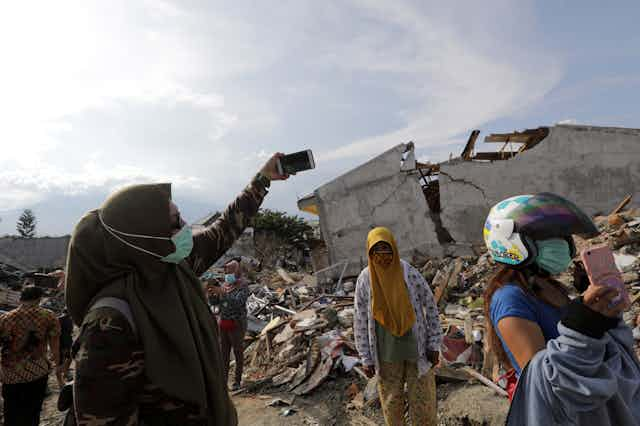Recently a selfie showing a group of women posing in front of the wreckage from the Sunda Strait tsunami went viral on social media.
The photo stirred debates on whether it is appropriate or not to take selfies at disaster areas. Some social media experts view this attitude can be accepted, saying that such practice is normal in the era of social media. I disagree. Taking selfies at disaster sites is wrong on many levels. Not only it poses risks but the action also indicates mental issues.
Selfies amid disasters is common everywhere
The act of taking selfies at disaster sites is oddly pervasive in Indonesia. In July 2015, a group of bystanders posed in front of a plane wreckage, in Medan, North Sumatra.
Then, in mid-2017 a massive crowd visited the location of terrorist attacks in Kampung Melayu, East Jakarta. They gathered around the crime scene – some raising their smartphones and taking pictures of the aftermath.
In other countries, taking selfies at disaster sites are both popular and controversial too. A health consultant was heavily criticised for using a selfie stick to take a group picture in a beach resort in Tunisia, where 38 people were killed by a gunman with links to the Islamic State (IS). In Nepal, a large group of people were reported to take a selfie with the wreckage of the Dhahara Tower, that was reduced to rubble after the 2015 Nepal earthquake.
Why it is not okay to take selfies in disasters.
Posing for selfies after horrendous events have become a regular activity in our daily life. It is almost as regular as people stopping by to see the aftermath of a traffic accident.
Media expert from Queen Mary University, UK, Yasmin Ibrahim wrote a thought-provoking article on this topic. She called this phenomenon as ‘disaster selfie’ or ‘disaster porn’ and defines it as a “disconcerting element of self-voyeurism in the post-disaster space”.
Carl Jung, a prominent psychoanalyst, argues that naturally, humans love to watch others’ suffer because it is entertaining and we are not directly affected by it. By watching others’ misery, we are given the chance to judge and laugh at people, but we are free from feeling the misery. He coined a term corpse preoccupation to refer to the personal desire to see strange and horrible things.
Jung believes that inside every human, there is a shadow that represents the darkest side of humanity. He argues that the more we suppress the shadow, the stronger it will become. This is why it is hard to avoid the temptation to stare at others’ despair. Therefore staring is irresistible as it fulfils the desire to let the negativity to rule, without committing any crimes.
When we stare at others’ despair, a prominent philosopher from Driyarkara School of Philosophy, Frankie Budi Hardiman also indicates that we are looking for more information. The kind of of look is driven by “the unnecessary need to know” and its nature is distant, judging, egocentric and exploitative. An onlooker uses victims as a mere entertaining object to fulfil their desire. In this case, seeing means nothing or even a gesture of refusal to take part. It is not directed to understand nor to help the victims.
It is terrifying to know that the habit of “staring” others’ misery, that implies others’ sorrow as an entertaining commodity, is deeply rooted in our society. The practice of staring becomes more upsetting when people take selfies as they don’t only see but also document the misery of others and distribute them on social media.
This is a serious moral issue because it is even worse than being a bystander. It is also a symptom of social pathology, which is the loss of empathy.
Safety concern
One would argue that taking pictures at disaster-affected areas is acceptable. Some may argue that the photos are needed to confirm the aid distributions. I do agree, partly, as long as it is not intended to gain (individual) trivial popularity on social media, such as getting more likes.
However, apart from moral hazards, taking a selfie in a disaster can create safety issues.
During an evacuation of a wildfire, for instance, curious people who want to take selfies could put their lives at risk of catching fire. Another thing is they may also hinder the evacuation process.
Focus on victims
One solution to control this attitude is by trying to put ourselves in the victims’ shoes. Would you like to have strangers posing for pictures while you suffer? I believe no human being is willing to be treated in such a way.
It is psychologically painful for the victims as they suffer from double victimisation – not getting necessary help while involuntarily made to be part of ‘the show.’
We must empathise with victims and consider what they are going through. I understand that information technology, particularly social media, has veered from the sublime to the ridiculous as it changes our ways to attain information. But if we are aware that we can do nothing to help the victim, at least please lessen their burden by not using them as an object to feed our nosiness.


